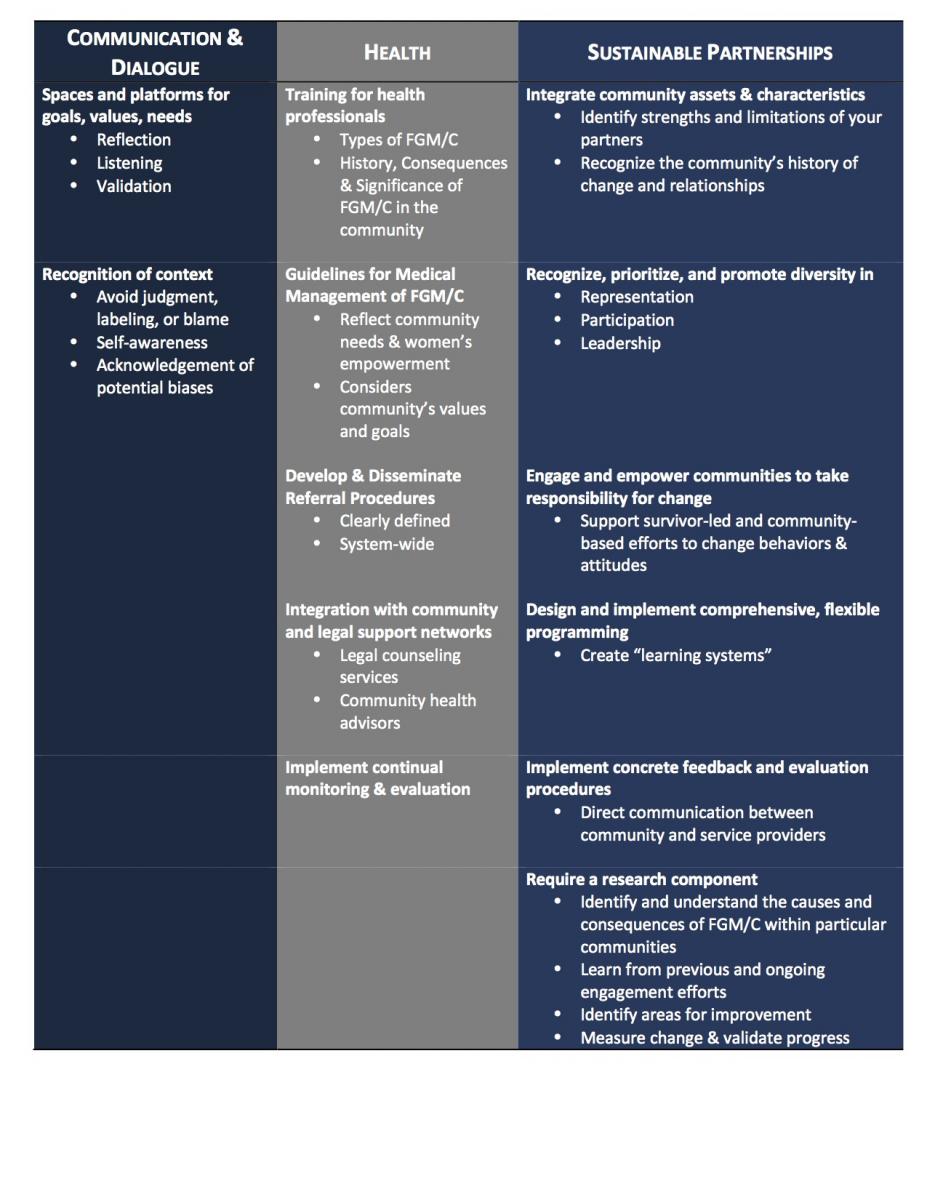Community Engagement Resources

The framework and resources presented below have been developed and collected as part of an ongoing project, “Improving FGM/C Healthcare and Clinical Guidelines Through Community Engagement and Leadership.”
The aims of this project include:
- Provide a rational for community engagement in FGM/C healthcare and policy-making
- Propose an adaptable framework for effective community engagement to improve health outcomes
- Connect service providers to resources, community-based organizations, and ongoing engagement efforts
This is just one aspect of a larger collaboration supported by a Complex Moral Problems grant (Georgetown University) and led by Ranit Mishori, MD, MHS, FAAFP (Department of Family Medicine, Georgetown University School of Medicine), Rebecca Reingold, JD (The O’Neill Institute for National and Global Health Law, Georgetown University), and Kevin T. FitzGerald, SJ, PhD, PhD (Pellegrino Center for Clinical Bioethics, Georgetown University Medical Center), that aims to help clinicians address complex medical-ethical-legal issues related to FGM/C.
Elements of Effective Engagement
The ongoing efforts to address FGM/C and to improve refugee and immigrant health are multidisciplinary and diverse. We looked at a broad set of organizations that work with those at risk of and survivors of FGM/C, refugee and immigrant populations, as well as resources on community engagement (see “Ongoing Efforts, Organizations, and Resources”). Recognizing the importance of multifaceted and collaborative approaches to improving health outcomes, we present our findings as a set of elements that could be found across many different contexts. Programming and community engagement tended to include a focus on communication & dialogue, work within the health sector, and forming sustainable partnerships. Neither the elements presented, nor the list of organizations and resources listed in the next section are intended to be exhaustive. Rather, they represent the beginnings of an adapatable framework for addressing FGM/C that can be applied in a variety of contexts, and an attempt to connect service providers to helpful resources and organizations.

Ongoing Efforts, Organizations, and Resources
Health/Clinical
- Refugee Women’s Health Clinic, Maricopa Integrated Health System
- Maya Centre – Confidential Counseling for Women
- FGM National Clinical Group (UK)
- Center for Refugee Health/Office of Community Medicine
- Somali Family Service (California, USA)
Community-based: Education, Training
- Sauti Yetu Center for African Women
- Tostan
- Integrate Bristol
- Hope Refugee Drop-in Center
- CEDOVIP (Raising Voices)
- Safe Hands for Girls
- There is No Limit Foundation
Advocacy and Support
- Daughters of Eve
- Dahlia Project
- The Orchid Project
- Forward UK
- Gender Based Violence (GBV) Prevention Network
- Raising Voices
- Stop FGM Middle East
- Equality Now
- Kepsteno Rotwo (Abandon the Knife) and Beyond FGM
Legal Services
Community Engagement Resources
- REPLACE Project (1 and 2) (EU) – Toolkit and Cyclic Framework for Social Transformation and Community Empowerment
- SASA! Approach from CEDOVIP (Raising Voices, Uganda)
- National Institute for Health and Care Excellence – Community Engagement Pathway
- Visioning Outcomes in Community Engagement (VOiCE) (UK)
- National Standards for Community Engagement (Scotland, UK)
References
Abdulcadir J, Rodriguez MI, Say L. Research gaps in care of women with FGM: an analysis. BJOG. 2015; 122(3): 294-303. http://onlinelibrary.wiley.com/doi/10.1111/1471-0528.13217/full Barret H, Brown K, Alhassan Y, and Beecham D. The REPLACE Approach: Supporting Communities to end FGM in the EU. Coventry University. 2015. http://www.replacefgm2.eu/documents/content/toolkit/executive_summary_print.pdf Boucher M. “Follow the Leader: Supporting Refugee Efforts to Self-Organize.” Center for Refugee Health. Conference. 2014. http://centerforrefugeehealth.com/wp-content/uploads/2015/10/Sat-830AM-Boucher-Follow-the-Leader.pdf Carey R. Female Genital Mutilation and Cutting (FGM/C). Office of Refugee Resettlement. US Department of Health and Human Services. State Letter. 15-08. 24 July 2015. http://www.acf.hhs.gov/orr/resource/state-letter-15-08 Coleman DL. The Seattle Compromise: Multicultural Sensitivity and Americanization. Duke Law Journal. 1998; 47: 717. http://scholarship.law.duke.edu/cgi/viewcontent.cgi?article=1024&context=dlj Darby R. Moral Hypocrisy or Intellectual Inconsistency? A Historical Perspective on Our Habit of Placing Male and Female Genital Cutting in Separate Ethical Boxes. Kennedy Institute of Ethics Journal. 2016; 26(2): 153-163. https://muse-jhu-edu.proxy.library.georgetown.edu/article/627257/pdf Earp BD. Between Moral Relativism and Moral Hypocrisy. Kennedy Institute of Ethics Journal. 2016; 26(2): 105-144. https://muse-jhu-edu.proxy.library.georgetown.edu/article/622485/pdf Elsayed DEM, Elamin RM, and Sulaiman SM. Female Genital Mutilation and Ethical Issues. Sudanese Journal of Public Health. 2011; 6(2): 63-67. http://www.sjph.net.sd/files/Vol6N2/Brief%20Communications1.pdf Hearst AA and Molnar AM. Female Genital Cutting: An Evidence-Based Approach to Clinical Management for the Primary Care Physician. Mayo Clinic Proceedings. 2013; 88 (6): 618-629. http://www.mayoclinicproceedings.org/article/S0025-6196%2813%2900264-4/fulltext Ireland A. “Addressing post-resettlement needs in an urban setting.” Center for Refugee Health. http://centerforrefugeehealth.com/wp-content/uploads/2015/10/Fri-11AM-Ireland-Addressing-Post-Resettlement-Needs-in-an-Urban-Setting1.pdf Louden K. AAP Retracts Controversial Policy on Female Genital Cutting. Medscape. 2 Jun 2010. http://www.medscape.com/viewarticle/722840 Nelson JL. Relativists and Hypocrites: Earp on Genital Cutting. Kennedy Institute of Ethics Journal. 2016; 26(2): 165-172. https://muse-jhu-edu.proxy.library.georgetown.edu/article/627258/pdf National Institute for Health and Care Excellence. Community engagement overview. 2017. https://pathways.nice.org.uk/pathways/community-engagement/community-engagement-overview Raising Voices. SASA! Mobilizing Communities to Inspire Social Change. 2013. http://raisingvoices.org/wp-content/uploads/2013/03/downloads/resources/Unpacking_Sasa!.pdf Reproductive Health Uganda. http://www.rhu.or.ug/ Scottish Community Development Centre. http://www.scdc.org.uk/what/voice/ Shweder RA. Equality Now in Genital Reshaping: Brian Earp’s Search for Moral Consistency. Kennedy Institute of Ethics Journal. 2016; 26(2): 145-154. https://muse-jhu-edu.proxy.library.georgetown.edu/article/627256/pdf US Government Accountability Office. Female Genital Mutilation/Cutting: Existing Federal Efforts to Increase Awareness Should be Improved. Report to the Honorable Harry Reid, Minority Leader, US Senate. GAO-16-645. June 2016. http://www.gao.gov/assets/680/678098.pdf WHO. Eliminating female genital mutilation: An interagency statement. WHO. 2008. http://apps.who.int/iris/bitstream/10665/43839/1/9789241596442_eng.pdf Wilkinson D. Cultural relativism and female genital mutilation. Practical Ethics Blog. University of Oxford. 7 Feb 2014. http://blog.practicalethics.ox.ac.uk/2014/02/cultural-relativism-and-female-genital-mutilation/ Younge M. “Complex Collaborations: Public, Private and Non-Profits Working (happily!) Together.” Center for Refugee Health. http://centerforrefugeehealth.com/wp-content/uploads/2015/10/Fri-11AM-Younge-Complex-Collaborations-Public-Private-and-Non-profits-Working-happily-Together.pdf
